Technical Details
The ICC V4 profiles were created using a slightly modified version of Little CMS. The modification was made to make sure the sum of the tristimulus values of the colorants yields exactly the tristimulus values of the media white point.
In all profiles the media white point is D50, which has the XYZ tristimulus values (0.9642, 1, 0.82491). Using the original Little CMS software produces a Rec. 2020 profile, for example, where the sum of the colorants is (0.96419, 0.99998, 0.82489). Accordingly, a conversion of RGB (1,1,1) to Lab yields (99.99941, -0.00009, 0.00022).
The reason for this isn’t an error in the Little CMS software but rather the fact that an ICC profile encodes all values as 16 bit digital numbers. This limited precision can cause small errors. My modification ensures that the sum of the encoded colorant values matches the encoded media white point. I don’t know if this is really of any practical relevance. I could not find any problems in applications like Photoshop using profiles created with the original Little CMS software. But when I opened the profiles in Matlab and carried out the calculations mentioned above, I encountered the small deviations from the expected values. I found a description of the same issue at Nine Degrees Below.
Dolby Vision
Dolby Vision is the most common flavor of HDR out in the field today. The system works in three parts. First you start with your master that has been graded using the PQ EOTF. Next you “analyse“ the shots in in your project to attach metadata about where the shadows, highlights and meat and potatoes of your image are sitting. This is considered layer 1 metadata. Next this metadata is used to inform the Content Mapping Unit or CMU how best to “convert” your picture to SDR and lower nit formats. The colorist can “override” this auto conversion using a trim that is then stored in layer 2 metadata commonly referred to as L2. The trims you can make include lift gamma gain and sat. In version 4.0 out now, Dolby has given us the tools to also have secondary controls for six vector hue and sat. Once all of these settings have been programmed they are exported into an XML sidecar file that travels with the original master. Using this metadata, a Dolby vision equipped display can use the trim information to tailor the presentation to accommodate the max nits it is capable of displaying on a frame by frame basis.
Многое зависит от ваших глаз
Я уже много раз говорил о том, что телевизоры со светодиодной (LED) подсветкой (включая те, что с технологией «квантовых точек» QD) дают насыщенные яркие цвета и более точную цветопередачу. По сути, это будто вы рисуете ту же картину, но только вам дали более дорогие и качественные краски.
Тут все дело в нашем восприятии цветов. Сама по себе LED-подсветка дает более узкий спектр света, если сравнивать с флуоресцентными лампами, которые раньше использовались в ЖК-телевизорах. В случае с QD-телевизорами спектр становится еще точней. В итоге получается достичь очень чистого требуемого оттенка. А чем «чище» тон, тем он кажется более ярким — такова природа нашего зрения. Например не такой «концентрированный» красный на старых телевизорах будет выглядеть менее ярким, чем на LED, и уже тем более на QD-моделях. В итоге более точное воспроизведение цветов, задуманных создателями контента.
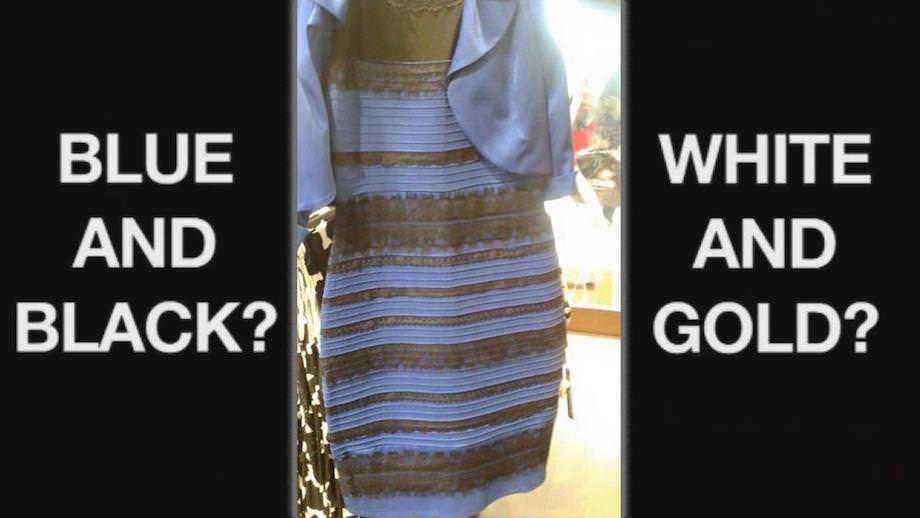
Однако есть и обратный эффект. Чем чище цвет, тем больше вероятность, что люди увидят его по-разному. От этого никуда не денешься, у каждого из нас есть свои особенности устройства глаза, значительных отличий нет, но некоторая разница присутствует. Другими словами, я могу видеть абсолютно реалистичный красный (как в жизни), а вам тот же цвет будет казаться не таким реалистичным. И мы оба правы.
Помните историю с платьем? Кто-то видел его бело-золотым, а другие сине-черным. В этом и скрыта проблема. Никто из нас не может точно знать, как другой видит какой-либо цвет, все субъективно.
Значит ли все это, что одна и та же модель нового телевизора может получить отрицательные и положительные отзывы только потому, что все видят цвета по-разному? Такое может быть, однако я думаю, что производители решат проблему и найдут ту переходную точку, когда все будут видеть «хорошие» цвета. Надеюсь, мы не будем смотреть один и тот же фильм и спорить о качестве цветопередачи.
HDMI ARC — обратная передача звука по HDMI
HDMI ARC (Audio Return Channel) — это технология обратной передачи звука, например, с телевизора на аудио-систему. Некоторые порты HDMI могут быть помечены как ARC (на телевизоре и AV-ресивере). Это означает, что звук можно отправлять обратно с телевизора на AV-ресивер через кабель HDMI, используемый ресивером для отправки изображения на телевизор.
И порты телевизора и приемника HDMI должны поддерживать эту технологию и обычно помечены как HDMI ARC. Это может означать, что не нужно подключать отдельный оптический кабель для передачи звука, а использовать подключение по HDMI r телевизору. Это также полезно, если на вашем телевизоре нет цифрового аудиовыхода.
eARC (Enhanced Audio Return Channel) – это новая версия, которая тоже поддерживает отправку звука с более высокой скоростью передачи. Для работы этой технологии необходимо включить ее на всех устройствах, соединенных по HDMI.
IMF
Inter-operable Master Format files can do a lot. For the scope of this article we are only going to touch on the HDR delivery side. The IMF is created from an MXF made from jpeg 2000s. The jp2k files typically come from the PQ tiff master. It is at this point that the XML file is married with picture to create one nice package for distribution.
Near Future
Currently we master for theatrical first for features. In the near future I see the “flippening” occurring. I would much rather spend the bulk of the grading time on the highest quality master rather than the 48nit limited range theatrical pass. I feel like you get a better SDR version by starting with the HDR since you have already corrected any contamination that might have been in the extreme shadows or highlights. Then you spend a few days “trimming” the theatrical SDR for the theaters. The DCP standard is in desperate need of a refresh. 250Mbps is not enough for HDR or high resolution masters. For the first time in film history you can get a better picture in your living room than most cinemas. This of course is changing and changing fast.
Sony and Samsung both have HDR cinema solutions that are poised to revolutionize the way we watch movies. Samsung has their 34 foot onyx system which is capable of 400nit theatrical exhibition. You can see a proof of concept model in action today if you live in the LA area. Check it out at the Pacific Theatres Winnetka in Chatsworth.
Sony has, in my opinion, the wining solution at the moment. They have a their CLED wall which is capable of delivering 800 nits in a theatrical setting. These types of displays open up possibilities for filmmakers to use a whole new type of cinematic language without sacrificing any of the legacy story telling devices we have used in the past.
For example, this would be the first time in the history of film where you could effect a physiologic change to the viewer. I have often thought about a shot I graded for The “Boxtrolls” where the main character, Eggs, comes out from a whole life spent in the sewers. I cheated an effect where the viewers eyes were adjusting to a overly bright world. To achieve this I cranked the brightness and blurred the image slightly . I faded this adjustment off over many shots until your eye “adjusted” back to normal. The theatrical grade was done at 48nits. At this light level, even at it’s brightest the human eye is not iris’ed down at all, but what if I had more range at my disposal. Today I would crank that shot until it made the audiences irises close down. Then over the next few shots the audience would adjust back to the “new brighter scene and it would appear normal. That initial shock would be similar to the real world shock of coming from a dark environment to a bright one.
HDR — высокий динамический диапазон изображения
HDR — это высокий динамический диапазон изображения. Техника, которая увеличивает динамический диапазон изображения и делает картинку более реалистичной. Ваш AV-ресивер должен будет поддерживать HDR для передачи этого типа контента на HDR-совместимый телевизор. Существуют разные версии HDR. Цепочка аппаратного обеспечения должна поддерживать определенную версию для ее воспроизведения.
Чтобы воспользоваться этой технологией, она должна поддерживаться как телепрограммой, так и контентом для просмотра, который особенно быстро растет на Netflix, YouTube и Amazon Prime Video. HDR значительно улучшает цвет, контраст и яркость, делая различные захватывающие сцены из фильмов или сериалов еще более реалистичными и четкими. Это особенно заметно на ночных изображениях, где HDR делает видимыми тени, отражения и выражения лица персонажа, которые не были бы видны без HDR.
Разница между HDR10, HDR10+ и Dolby Vision
Существует несколько стандартов HDR. И отличия между ними следующие.
- Глубина цвета и возможное количество оттенков.
- Dolby Vision поддерживает 12 бит цвета.
- Есть разница в яркости.
- Dolby Vision требует лицензирования.
А еще существует несколько форматов Dolby Vision для кинотеатров, Blu-ray дисков, стриминговых платформ и для iPhone.
В итоге мы наблюдаем очень большие сложности в создании HDR видеоконтента; в платформах, которые не позволяют одновременно загружать HDR и SDR; и в устройствах, которые имеют совершенно разные характеристики и по-разному воспроизводят контент.
Я считаю, что в ближайшем будущем HDR контент не будет пользоваться массовым спросом.
Частота обновления
Часто в разрешении производители также любят упоминать частоту обновления экрана, которая измеряется в герцах. Этот параметр определяет, сколько раз в секунду изображение может обновляться на экране телевизора. Чем выше число герц, тем плавнее и приятнее для глаз будет воспроизводиться видеоконтент. Самые дешевые телевизоры ограничены частотой 60 Гц, в то время как более продвинутые модели имеют частоту до 120 Гц. Это особенно оценят владельцы игровых консолей, так как более быстрое обновление изображения на экране также даст им преимущество перед виртуальными соперниками.
Rec. 2020 или DCI P3
Сейчас ведется много споров и дискуссий касательно новых стандартов. С одной стороны, у Rec.2020 намного больше цветов, чем у Rec.709, но с другой — индустрия еще не готова к переходу на Rec.2020. Плохо это или хорошо? Мне кажется, что есть куда стремиться, а значит — хорошо. Вероятней всего, с Rec.709 телевидение перейдет на стандарт DCI P3. Именно это цветовое пространство используется в современных кинотеатрах. Стандарт уже хорошо знаком студиям, есть большая вероятность, что скоро появятся ремастированные версии старых фильмов, подогнанные под новый стандарт. Несмотря на то, что вероятность перехода на P3 более высока, это не значит, что Rec.2020 забудут — сейчас DCI P3, а потом Rec.2020. Думаю, переход от формата к формату не станет слишком сложной задачей, это как добавить новый саундтрек к уже отснятому материалу.
Количество цветов
Не нужно путать цветовой охват и количество цветов, которое способен отобразить экран. За цветовой охват отвечает технология производства дисплея, а за количество цветов отвечает количество бит в матрице на один цвет. Экраны Full HD поддерживают 8-битный цвет, что позволяет им отображать до 16,7 млн цветов. А экраны Ultra HD поддерживают (должны поддерживать по спецификации) 12 бит на канал цветности, что соответствует 69 миллиардам отображаемых цветов.
Флагманы среди тв каждой фирмы на каждый канал цветности своих экранов имеют по 10 бит, что соответсвует 1 миллиарду цветов. Младшие модели по 8 бит.
Цветовой охват показывает, какие цвета способен отображать экран. А количество цветов показывает, на сколько градаций можно разделить цветовой диапазон, определяемый цветовым охватом. Чем больше количество цветов, тем больше дисплей отобразит оттенков и полутонов. Если увеличивать цветовой охват без увеличения количества цветов (количество бит на канал), то на градиентах (плавный переход от одного цвета к другому) будут видны линии перехода на другой оттенок.
Получается, что новый стандарт Ultra HD означает не только более высокое разрешение, но и другое качество изображения, увеличивается количество информации о цвете. Но существующие дисплеи не способны воспроизвести такое качество, вот и приходится искать новые методы LED подсветки, которые увеличивают цветовой охват. На сегодня используют квантовые точки.
О Blu-ray-дисках формата 4K
Что касается новых Blu-ray-дисков с разрешением 4K, то тут все более-менее хорошо. На одном и том же диске может храниться информация, которая будет по-разному отображаться в зависимости от типа телевизора — если запустить диск на «обычном» 4K-телевизоре, то видео проиграется в рамках стандарта Rec.709, а если просмотреть тот же диск на телевизоре с расширенной цветопередачей, то и контент (видео) изменится в соответствии с форматом.
 Прототип 4К Blu-Ray-проигрывателя от Panasonic
Прототип 4К Blu-Ray-проигрывателя от Panasonic
Короче говоря, специальные 4K-Blu-ray-диски для расширенной цветопередачи не понадобятся. Это плюс.
Additional Information
Tone mapping
Although we only publish the results for the color space, we also measure the tone mapping using the CalMan software. In the photos above with the color gamuts of the Vizio TVs, there are horizontal bar graphs on the left. This is the tone mapping, and it measures the standard deviation of each color compared to the color it’s supposed to display. It’s basically telling you how accurate the display is with the colors in the color space. More often than not, a TV without a wide color gamut has bad tone mapping because it can’t display the colors as needed, but it’s also possible a TV with a wide color gamut has bad tone mapping (like the LG B1 OLED). Not only do you want TVs to be able to display a wide range of colors, but you want them to do it accurately.
Other Color Gamuts
Color gamuts are created by telecommunications standards organizations and help establish concrete specifications for what the TV must be capable of doing. To meet a given color gamut’s specifications, a TV must be able to display all of the colors included in that space. There are a few main color gamuts that are important to TVs, such as Rec.709, DCI P3, Rec. 2020, and Rec. 2100, to name a few.
Rec. 709 is a basic color space used in SDR content that most HD TVs should easily display. However, it’s fairly limited and doesn’t display the wide range of colors needed for HDR content. DCI P3 and Rec. 2020 are the ones that we measure, and they’re the most common ones for HDR content. Rec. 2100 is an even wider version of Rec. 2020. As technology evolves, wider color spaces will be released, and eventually, content will use those.
Advantage of Quantum Dot TVs
You may have heard of quantum dot technologies, commonly marketed as QLED, ULED, or NanoCell. Essentially, these LED-backlit TVs have a quantum dot layer between the backlight and pixels to emit light to create a wider range of colors by providing better control over each subpixel. Quantum dot TVs often have an advantage over standard TVs by displaying a wider color gamut. Nearly all quantum dot TVs we’ve tested display a wide color gamut, but there are exceptions, like the Samsung QN800A 8k QLED. However, if you feel that you watch a lot of HDR content and want a TV to display a wide color gamut, a quantum dot model is usually a safe bet.
Color Gamut vs Color Volume
The color volume and color gamut are related to each other because they’re tested at the same time, but they represent different things. While the color gamut tells us how many different colors a TV can display, the color volume represents the shades of those colors. In simple terms, the color gamut tells us that the display can show a specific color, like red, but the color volume shows at which brightness levels it displays that color.
Testing Color Gamut on TVS vs Monitors
We test the color gamut on TVs and monitors very differently, so you can’t compare the two at all. On TVs, we measure the Rec. 2020 and DCI P3 color spaces separately, but we measure the DCI P3 color gamut on monitors by only sending the Rec. 2020 color space and limiting it to the DCI P3 primaries. We also don’t measure the uv coverage on monitors. We measure both the SDR and HDR color gamut on monitors, but we only do the HDR color gamut for TVs.
Usage
The typical workflow in video or motion-picture is not color-managed. People rely on the calibration of a display or of a projector. Professional displays can be adjusted to meet calibration targets within small tolerances. When the same image data is sent to two well-calibrated displays, the images will match.
You can use the profiles to tag RGB images that have been created and viewed on a reference display or on a digital projector. If you view the images in a color-managed application, it can recreate the original image even if your desktop monitor is not adjusted to the same color space as the reference display.
Внешние ссылки [ править ]
| vтеЦветовое пространство | |
|---|---|
|
|
| САМ |
|
| CIE |
|
| RGB |
|
| YUV |
|
| Другой |
|
| Цветовые системы и стандарты |
|
| Чтобы узнать о возможностях зрения организмов или машин, см. Цветовое зрение . |
Глубина цвета
Другой важный момент — это глубина цвета или цветовая разрядность. Тут все сложнее. У телевизоров нет какой-то бесконечной палитры цветов, чтобы выбирать и создавать всевозможные оттенки. Каждому цвету дан номер. Современные телевизоры используют 8-битную систему, что примерно означает 256 оттенков для каждого тона (не совсем так, но не будем углубляться). Например, синий под номером «20» будет очень темным (почти черным), а 220-й синий — это светло-голубой.
Если помножить друг на друга (совместить цвета) получится не так уж и мало — всего 8-битами на цвет могут быть представлены 16.7 млн оттенков. Казалось бы, это очень много. Но недостаточно. Наши глаза видят в несколько раз больше.
Сравнение 8-битного и 10-битного отображения градаций серого
Уже сегодня делают телевизоры и 4K-Blu-ray-проигрыватели с 10-битной системой. Это означает, что у каждого цвета получается 1024 оттенка. Гораздо интереснее! Картинка получается натуральней.
А если соединить улучшенную разрядность и расширенную цветовую гамму, то мы получим огромный скачок «цветового реализма».
Кроме того, 8-битное «описание» цветов ограничивает и детализацию картинки, если говорить о контрастности и яркости.
Color Spaces
Three color spaces are commonly used in video and motion-picture productions: ITU Rec. 709, ITU Rec. 2020, and DCI. The figures show the color spaces in the CIE xy and in the CIE 1976 UCS diagram, respectively.
The white point of the colorspaces defined in Rec. 709 and Rec. 2020 is D65. The XYZ encoding for digital cinema allows a variable white point. I provide three different profiles for the digital cinema P3 color space with white points of D65, D60, and DCI.
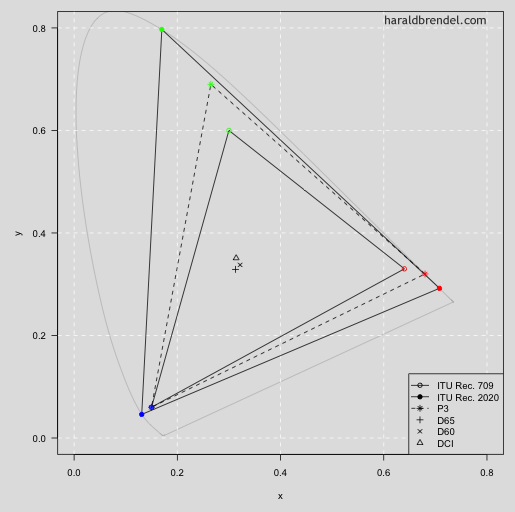
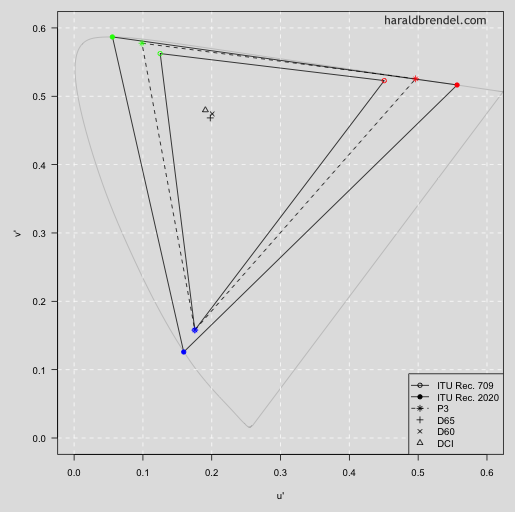
ITU Rec. 709
The normative reference is ITU-R BT.709: Parameter values for the HDTV standards for production and international programme exchange. A common misconception is that the same standard defines the transfer curve of the display. That didn’t happen, however, until the following recommendation was released: ITU-R BT.1886: Reference electro-optical transfer function for flat panel displays used in HDTV studio production.
ITU Rec. 1886 says that the reference EOTF for displays used in HDTV production and programme interchange should be
a power function with an exponent («gamma») of 2.4. Exactly this is assumed in the provided profile: a display that has the color primaries specified in ITU Rec. 709 and that has a gamma of 2.4.
ITU Rec. 2020
The normative reference is ITU-R BT.2020: Parameter values for ultra-high definition television systems for production and international programme exchange.
Rec. 2020 assumes that the encoding function of image sources is adjusted so that the final picture has the desired look, as viewed on a reference monitor having the reference decoding function of Recommendation ITU-R BT.1886.
The introduction states that if it is shown that an alternative electro-optical transfer function (EOTF) will provide significant benefits without also imposing significant disadvantages, then this Recommendation should be extended to enable use with an improved EOTF.
For now, I therefore assume that Rec. 2020 displays have a gamma of 2.4. That’s the reason I named the profile Rec2020-Rec1886.icc.
P3
The document SMPTE RP 431-2:2011 D-Cinema Quality — Reference Projector and Environment defines the minimum gamut for a Reference Projector
. For historic reasons this color space is called P3. The document isn’t freely available. Before standardization by SMPTE the specification was established by the Digital Cinema Initiatives (DCI).
The same document specifies the transfer function to be a power function with an exponent of 2.6.
The provided DCI profiles are supposed to be used with RGB images created and viewed on a display or on a digital projector that has the aforementioned gamut and transfer function. The three profiles assume the display/projector is balanced to one of the following white points, respectively.
- D65
- This is the white point used by the video color spaces Rec. 709 and Rec. 2020. The chromaticity coordinates are x = 0.3127 and y = 0.3290.
- D60
- This white point has a correlated color temperature of 6000K. The chromaticity coordinates are x = 0.32168 and y = 0.33767.
- DCI
- This is the original white point for the digital cinema reference projector. The point lies above the daylight locus. The chromaticity coordinates are x = 0.314 and y = 0.351.
I know there are some misunderstandings lurking and I want to make this perfectly clear. The profile DCID65.icc, for example, is for images that have been displayed on a projector balanced to D65. The RGB signal (1,1,1) produces D65.
Подсветка
Каждый телевизор тем или иным образом освещает свой экран. Самый экономичный способ сделать это – подсветить экран с помощью светодиодной ленты. Телевизоры Superior имеют подсветку, что позволяет включать свет только там, где это необходимо
Важно, чтобы телевизор имел как можно больше светодиодных элементов и лучше регулировал затемнение, чтобы он мог более точно освещать яркие детали изображения, а также сохранял детали в самых темных местах
Вероятно, наиболее интересным из представленных решений является Quantum Matrix Technology Pro, которую можно найти на телевизорах Neo QLED 8K. Он сочетает в себе тысячи самых ярких мини-светодиодных элементов со сверхточными слоями управления затемнением и разрешением 8K, обеспечивая совершенно новый уровень детализации изображения.
HDTV, UHDTV and Color Spaces
The color spaces supported by TVs and mobile devices have evolved significantly over the years. Support for wider color gamut is one of the key developments in display technology, along with increasing resolutions and frame rates, enabling devices to display colors that are closer to what the eye perceives and is also required for High Dynamic Range (HDR) media.
This section reviews few of the popular SDR and HDR color spaces supported by consumer display devices like TVs, PC monitors, tablets and mobiles.
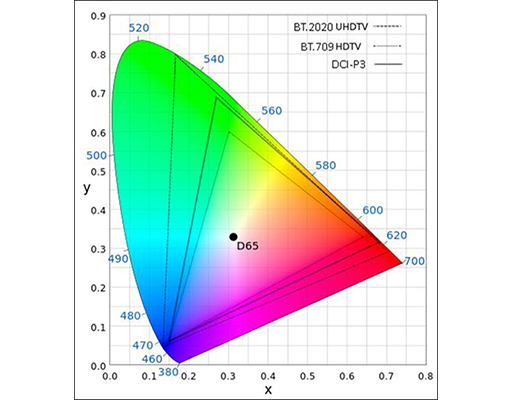
Figure 1 above depicts various color spaces and their coverage of the CEI 1931 color space.
-
Rec 709 Color Space
ITU-R Recommendation BT.709, first approved in 1990 and often referred to as Rec. 709 or BT.709, standardizes the format of High Definition Television (HDTV). This color space is identical to the sRGB color space and covers 35.6% of the CIE 1931 color space. All HD displays should be able to cover 100% of the Rec. 709 color space. -
DCI/P3 Color Space
DCI-P3 is a popular high dynamic range (HDR) RGB color space that was introduced in 2007 by SMPTE and features a color gamut much wider than Rec. 709, covering 45.5% of all colors perceptible to humans as per the CIE 1931 color space. All Digital Cinema Projectors are capable of displaying the entire DCI P3 color space.
DCI/P3 has assumed importance in recent times since this is the reference color gamut for current ‘Ultra HD Premium TV’s, which are expected to support at least 90% of the DCI/P3 color space with a minimum brightness of 0.05nits and maximum brightness of 1000nits. -
The Rec. 2020 color space
ITU-R Recommendation BT.2020, more commonly known by the abbreviations Rec. 2020 or BT.2020 is the de facto standard for HDR10 which defines various aspects of UHDTV such as resolution, frame rates, bit depth, chroma subsampling and color space. The associated color space is also commonly referred to as Rec. 2020. It covers 75.8% of all colors perceptible to humans as per the CIE 1931 xy color space.
In August 2015, the Consumer Electronics Association (CEA) standardized the HDR10 Media Profile format for all HDR compatible display devices. Support for REC.2020 color primaries and ST2084 EOTF transfer characteristics are essential to this format.
Внешние ссылки [ править ]
| .mw-parser-output .navbar{display:inline;font-size:88%;font-weight:normal}.mw-parser-output .navbar-collapse{float:left;text-align:left}.mw-parser-output .navbar-boxtext{word-spacing:0}.mw-parser-output .navbar ul{display:inline-block;white-space:nowrap;line-height:inherit}.mw-parser-output .navbar-brackets::before{margin-right:-0.125em;content:»»}.mw-parser-output .navbar li{word-spacing:-0.125em}.mw-parser-output .navbar-mini abbr{font-variant:small-caps;border-bottom:none;text-decoration:none;cursor:inherit}.mw-parser-output .navbar-ct-full{font-size:114%;margin:0 7em}.mw-parser-output .navbar-ct-mini{font-size:114%;margin:0 4em}.mw-parser-output .infobox .navbar{font-size:100%}.mw-parser-output .navbox .navbar{display:block;font-size:100%}.mw-parser-output .navbox-title .navbar{float:left;text-align:left;margin-right:0.5em}vтеЦветовое пространство | |
|---|---|
|
|
| САМ |
|
| CIE |
|
| RGB |
|
| YUV |
|
| Другой |
|
| Цветовые системы и стандарты |
|
| Чтобы узнать о возможностях зрения организмов или машин, см. Цветовое зрение . |
Подведем итог
Для нас лучше всего то, что производители телевизоров уже начали постепенно задействовать новые технологии. Все не так быстро и просто, как, например, установить новое приложение на Smart TV, но зато мы получим и другие «бонусы». Вероятность того, что ваш новый телевизор обладает поддержкой расширенного цветового пространство довольно высока. А если не торопиться и подождать пару лет, то вы точно купите именно такой телевизор.
Вообще уже в этом году стоит ожидать довольно серьезных улучшений в области реализма цветов. Контент скоро появится, и повезет тем, у кого будут подходящие телевизоры и 4K-Blu-ray-проигрыватели.
Первая часть: Как новые форматы Ultra HD и 4К совершат цветовую революцию. Часть первая
Оригинал: Ultra HD 4K TV color, part II: The (near) future
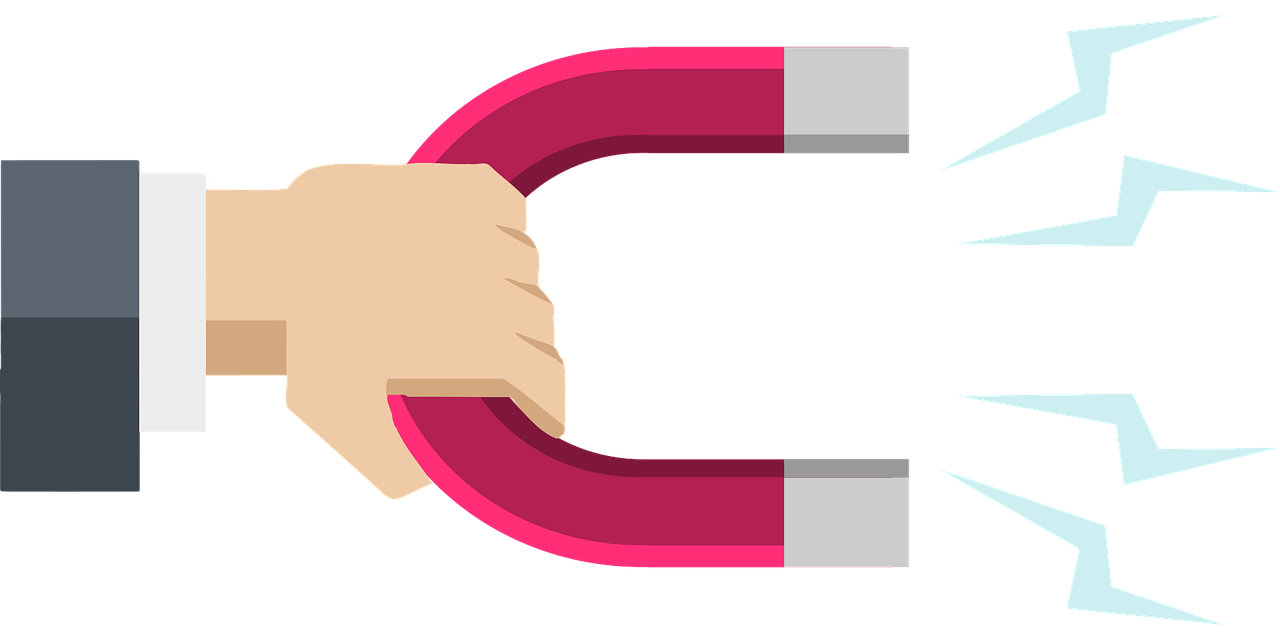





![Как новые форматы ultra hd и 4к совершат цветовую революцию. часть вторая [перевод] • stereo.ru](http://thelawofattraction.ru/wp-content/uploads/e/8/8/e88ca912f1c855196fe3c65a019bc1b9.jpeg)












![Рек. 2020 г.содержание а также технические детали [ править ]](http://thelawofattraction.ru/wp-content/uploads/1/e/7/1e79cb9ed88c1d5bad156e837cb39212.png)





![Как новые форматы ultra hd и 4к совершат цветовую революцию. часть вторая [перевод]](http://thelawofattraction.ru/wp-content/uploads/9/6/b/96b1597570f5a3645660ed036ccf15a1.jpeg)








